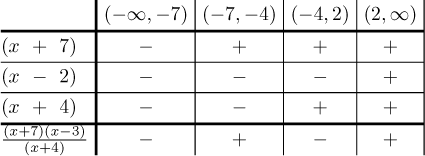First we will explore the solution by factoring. We start by rewriting the
expression like this:

The factors have the following zero points:
x = −7,
x = −4,
x = 2. Thus the real line splits
into four regions and we determine signs of linear factors in each region by
substituting numbers from inside the regions. After that we determine the
sign of the whole expression by combining the signs using the usual sign
algebra (two minuses give plus).

Note: Another way to determine signs for linear factors (and any expression
with just one zero point) is this. First mark the number in the chart that
made the expression zero. For instance, in the first row (with
x + 7) it
would be −7, so we mark the line between the column with
(−∞,−7) and the column with
(−7,−4). This becomes the dividing line between minuses and pluses. To
determine whether it should now go in the order "− +" or
"+ −" we
simply imagine that we put a huge number into
(x + 7). Obviously we get
a positive answer, so the pluses should come on the right. Check that the
same procedure will work with the next two rows.
Anyway, we obtained the intervals (−7,−4) and
(2,∞)
as possible solutions. The
last step is to determine whether endpoints should be included. This is done
simply by substituting them into the expression and checking whether the
outcome will satisfy the given inequality (that is, whether we get something
greater or equal to zero). It turns out that −7 and 2 work (they give 0,
which is O.K.), but −4 does not work.
Conclusion: The solution is
x∈[−7,−4) ∪ [2,∞).
Alternative solution:
We can also try to simplify the inequality by getting rid of the fraction,
that is, to multiply the inequality by (x + 4). However, multiplying an
inequality requires that we check on the sign of the term that we use and if
it is negative, switch the direction of the inequality. Since x is not
given, we have to try both possibilities, when
(x + 4) > 0
and when (x + 4) < 0.

These two inequalities can be again solved by factoring, but if we wanted to
do it, we could have used the first solution right away and save some work.
So we try another way, by sketching the graph of
x2 + 5x − 14. We know that it is an upward-oriented
parabola, using the quadratic formula we easily find the roots
−7 and 2, so
it looks like this:

From this we easily guess the solutions for the left and right alternative,
but each of them then has to be intersected with the interval in which that
particular solution is valid.

Since these were alternatives and we were free to choose, the final solution
is the union, so we get as above that
x∈[−7,−4) ∪ [2,∞).
![]()



